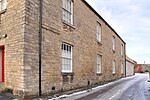Cogglesford Mill
Grade II listed buildings in LincolnshireGrade II listed industrial buildingsGrade II listed watermillsIndustrial archaeological sites in EnglandMill museums in England ... and 4 more
Museums in LincolnshireSleafordUse British English from December 2021Watermills in Lincolnshire

Cogglesford Mill (sometimes referred to as Coggesford) is a Grade II listed working watermill in Sleaford, Lincolnshire. It is possibly the last working Sheriff's Mill in England.
Excerpt from the Wikipedia article Cogglesford Mill (License: CC BY-SA 3.0, Authors, Images).Cogglesford Mill
East Gate, North Kesteven
Geographical coordinates (GPS) Address Phone number Website Nearby Places Show on map
Geographical coordinates (GPS)
| Latitude | Longitude |
|---|---|
| N 53.001687 ° | E -0.400187 ° |
Address
Cogglesford Mill Cottage
East Gate
NG34 7EE North Kesteven
England, United Kingdom
Open on Google Maps








